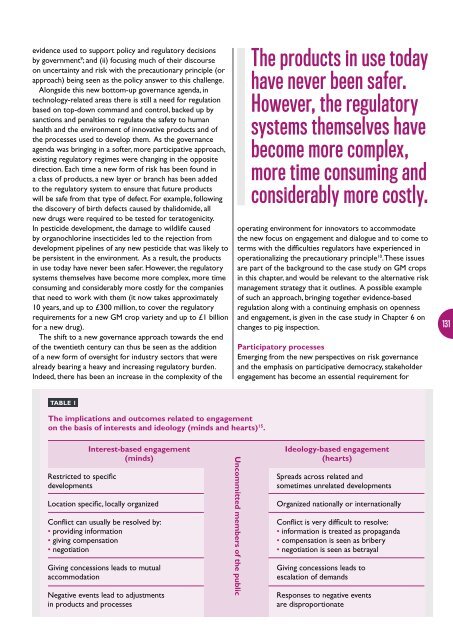14-1190b-innovation-managing-risk-evidence
14-1190b-innovation-managing-risk-evidence
14-1190b-innovation-managing-risk-evidence
You also want an ePaper? Increase the reach of your titles
YUMPU automatically turns print PDFs into web optimized ePapers that Google loves.
<strong>evidence</strong> used to support policy and regulatory decisions<br />
by government 9 ; and (ii) focusing much of their discourse<br />
on uncertainty and <strong>risk</strong> with the precautionary principle (or<br />
approach) being seen as the policy answer to this challenge.<br />
Alongside this new bottom-up governance agenda, in<br />
technology-related areas there is still a need for regulation<br />
based on top-down command and control, backed up by<br />
sanctions and penalties to regulate the safety to human<br />
health and the environment of innovative products and of<br />
the processes used to develop them. As the governance<br />
agenda was bringing in a softer, more participative approach,<br />
existing regulatory regimes were changing in the opposite<br />
direction. Each time a new form of <strong>risk</strong> has been found in<br />
a class of products, a new layer or branch has been added<br />
to the regulatory system to ensure that future products<br />
will be safe from that type of defect. For example, following<br />
the discovery of birth defects caused by thalidomide, all<br />
new drugs were required to be tested for teratogenicity.<br />
In pesticide development, the damage to wildlife caused<br />
by organochlorine insecticides led to the rejection from<br />
development pipelines of any new pesticide that was likely to<br />
be persistent in the environment. As a result, the products<br />
in use today have never been safer. However, the regulatory<br />
systems themselves have become more complex, more time<br />
consuming and considerably more costly for the companies<br />
that need to work with them (it now takes approximately<br />
10 years, and up to £300 million, to cover the regulatory<br />
requirements for a new GM crop variety and up to £1 billion<br />
for a new drug).<br />
The shift to a new governance approach towards the end<br />
of the twentieth century can thus be seen as the addition<br />
of a new form of oversight for industry sectors that were<br />
already bearing a heavy and increasing regulatory burden.<br />
Indeed, there has been an increase in the complexity of the<br />
The products in use today<br />
have never been safer.<br />
However, the regulatory<br />
systems themselves have<br />
become more complex,<br />
more time consuming and<br />
considerably more costly.<br />
operating environment for innovators to accommodate<br />
the new focus on engagement and dialogue and to come to<br />
terms with the difficulties regulators have experienced in<br />
operationalizing the precautionary principle 10 . These issues<br />
are part of the background to the case study on GM crops<br />
in this chapter, and would be relevant to the alternative <strong>risk</strong><br />
management strategy that it outlines. A possible example<br />
of such an approach, bringing together <strong>evidence</strong>-based<br />
regulation along with a continuing emphasis on openness<br />
and engagement, is given in the case study in Chapter 6 on<br />
changes to pig inspection.<br />
Participatory processes<br />
Emerging from the new perspectives on <strong>risk</strong> governance<br />
and the emphasis on participative democracy, stakeholder<br />
engagement has become an essential requirement for<br />
131<br />
TABLE 1<br />
The implications and outcomes related to engagement<br />
on the basis of interests and ideology (minds and hearts) 15 .<br />
Restricted to specific<br />
developments<br />
Interest-based engagement<br />
(minds)<br />
Location specific, locally organized<br />
Conflict can usually be resolved by:<br />
• providing information<br />
• giving compensation<br />
• negotiation<br />
Giving concessions leads to mutual<br />
accommodation<br />
Negative events lead to adjustments<br />
in products and processes<br />
Uncommitted members of the public<br />
Ideology-based engagement<br />
(hearts)<br />
Spreads across related and<br />
sometimes unrelated developments<br />
Organized nationally or internationally<br />
Conflict is very difficult to resolve:<br />
• information is treated as propaganda<br />
• compensation is seen as bribery<br />
• negotiation is seen as betrayal<br />
Giving concessions leads to<br />
escalation of demands<br />
Responses to negative events<br />
are disproportionate


